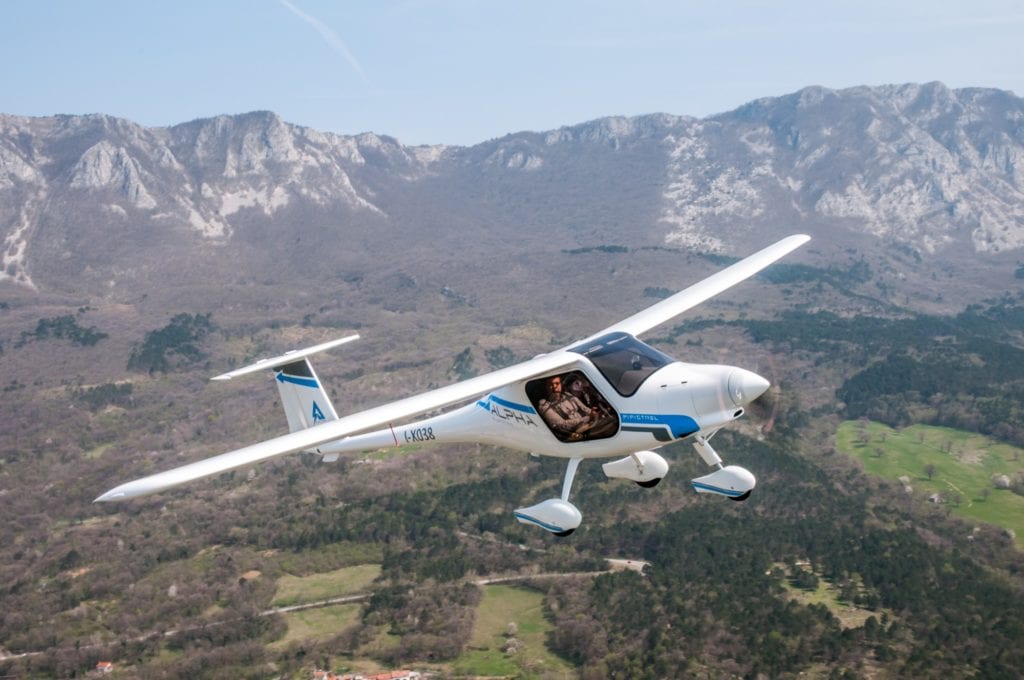
While there are electric training aircraft, such as this Pipistrel ALPHA Electro, the test bed for the broad electrification of commercial aircraft will likely be the regional aircraft market. Photo: Pipistrel
While aviation companies are predicting the electrification of airliners, the commercial test bed will be regional aviation, including urban air mobility, and the fielding timeline looks to be 2030 at the earliest.
Such a timeline is significant for avionics manufacturers, as they consider the development of technologies that will dovetail with electric aviation.
“Regional aviation is our focus, not by accident,” Thomas Bell, the CEO of Rolls-Royce North America, said during an electric flight panel at the March 5 U.S. Chamber of Commerce Aviation Summit 2020 in Washington, D.C.
The company’s focus on electric engine powered regional aircraft “gives you certain advantages, as you try to crack the nut of the power density, the weight and the size,” Bell said. “We’ll see this evolve up the food chain of aviation starting with regional aviation, starting with hybrid. I don’t think it’s unrealistic to have vistas of 2030 or early 2030s as when you’ll see that commercially viable.”

Thomas Bell, CEO of the North American division of Rolls Royce, Dr. Eric Ducharme, chief engineer and GM of GE Aviation, and Gary Spulak, president of Embraer joined a panel at the U.S. Chamber of Congress 2020 Aviation Summit in Washington DC last week. Photo: Seabury Capital
OEMs and their suppliers will likely have to map out the incorporation of electric-enabled technologies carefully.
Gary Spulak, another panelist and the president of Embraer Aircraft Holding, Inc., said the airframe manufacturer’s view of the future of electric airliners comes with a timeline that takes “seven to eight years, at least, to bring a product from conceptualization to first delivery.” Embraer however is still actively investing in the development of future electric-powered aircraft.
Last August, Embraer unveiled the single-engine electric demonstrator aircraft that it is developing in collaboration with another Brazilian company, WEG. First flight of the aircraft, based on the Embraer single-engine EMB-203 Ipanema crop duster, is on track to occur later this year. On the UAM front, EmbraerX, the company’s disruptive U.S.-based subsidiary, signed an agreement to assist on technical engineering, certification and business development for the hybrid VTOL unmanned cargo delivery aircraft currently being developed by San Francisco-based startup Elroy Air.

Embraer is using a single-engine electric demonstrator aircraft to research and develop electric propulsion technology. Photo: Embraer
“When you incorporate these technologies, you don’t want to have new things that pop up in the middle of this timeline that could add more value to the salability and the value proposition for our customer. You want to be able to capture all those, but yet you’ve already launched the process so you can’t backtrack, and with the way the process is so dynamically advancing, this is a hard thing for us to do. Our suppliers and the research they do and their impression of what the customer needs all comes together in this and can only make the product successful if this happens,” Spulak said.
Other major aviation companies that are also using the regional airliner sector as a testbed include United Technologies Corp., which is currently developing a flight demonstrator with an engine on one side replaced by a hybrid-electric power plant produced through collaboration with its Collins Aerospace and Pratt & Whitney subsidiaries.
Collins Aerospace is also building out a $50 million high-voltage lab, “The Grid,” that will serve as a design and testing center for a 1-megawatt motor, motor controller and battery system for UTC’s hybrid electric demonstrator aircraft, Project 804. Collins also has experience providing electrical power systems for what is currently the industry’s most electric commercial airliner in service right now, the Boeing 787.
Eric Ducharme, the chief engineer and general manager of GE Aviation, during the Aviation Summit panel, also referenced the electric footprint of the 787. He said that the electrification effort “is happening now in different sectors” of aviation.
“If you think of a 787, it’s a one megawatt flying grid,” he said. “There’s already all electric trainers. In eVTOL, there are hundreds of programs that the FAA and EASA are evaluating and working through right now.”
“We’ve been working on some of the enabling technologies for over a decade, more focused on the transport scale,” Ducharme said. “We’ve done some very key demos. Back in 2015, we demonstrated power extraction at the megawatt level from an engine at sea level. We took it to NASA in 2016 and showed that you could transiently draw power at that level from an engine and do it operably. So we’ve got our first generation behind us in terms of motor generator. This is moving the needle in terms of the state of the art of efficiency, power density around motors, generators, power conditioning, electronics, [and] high voltage systems. It’s really important to consider weight in aviation applications, obviously. You can’t carry tons of cabling around a large aircraft. High voltage enables that, but that comes with some challenges around insulation systems and so forth.”
Ducharme said that GE Aviation has been working on systems integration “of all these components at our electric power center in Dayton, Ohio, demonstrating second generation capability there. Right now, we’re at test at NASA’s [Glenn Research Center] facility in Cleveland demonstrating the altitude capability and working methodically towards a flight test and safe demonstration of all these technologies.”